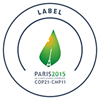�
Our Common Future Under Climate Change
International Scientific Conference 7-10 JULY 2015 Paris, France
Ian D. Keating
Fuel poverty: Assessing who is at risk
201507-09
By Arnaud F�che
Audrey�s poster will be presented on Day 4: Collective Actions and Transformative Solutions afternoon at the UNESCO venue and at the UPMC in the evening, during the social event.
People who live far from their office, drive old cars, are on a low income and live in countries with high fuel prices are most at risk of falling into debt should ill-conceived energy policies be introduced. The problem is that when governments currently assess the percentage of the population that is �fuel poor�, they only take into account the money spent on fuel as a ratio of the household income, and they only consider domestic energy.�
For better public fuel policies, Audrey Berry and her research colleagues from the Centre International de Recherche sur l'Environnement et le D�veloppement (CIRED), are advocating for more accurate fuel poverty measurements, which take these other factors into account.�
"The better the measurement is, the more accurate the targeted population is and the more efficient the following public policy," Berry said.
With rising fuel prices in France due to depleting fossil fuels, an increasing number of households will be facing difficulties with their energy budget. Since 2010, fuel poverty has been an emerging topic in France but the transport dimension has not yet received much attention in the research community.
When talking about implementing new public policies, the indicators are at the root of the measurement. An indicator is a simplification of the reality, using various factors, that allow us to have a representation of the issue.�
What makes a good indicator is having a well-balanced mix between simplicity and accuracy of the populations targeted. Too simple and the populations spotted might not be the right ones, with at-risk households cast aside. Too complicated, and the result may not be significant.
A good quality indicator is also an indicator that can adapt to the evolution of its subjects, without being entirely remodeled. The better the targeted populations are assessed, the more cost-efficient the public policy is.
All these factors need to be taken into account to develop a good indicator if one wants to develop a good public policy. A new composite indicator like this one is a powerful tool to attain social equity, and is therefore likely to ease social acceptance of, say for example, carbon tax.
The current ratio indicator identifies 14.4% of French households as fuel poor today, but it only considers domestic energy. The composite indicator identifies 2% households as fuel poor today which is much lower.�
The problem is more of vulnerability in the transport sector (risk to face difficulties and become fuel poor if fuel prices keep on rising) rather than fuel poverty directly (people are already cutting back on heating today).
When considering high fuel spending, poor conditions of mobility, or situation of fuel dependency, Berry found a total of 17.2% households (4.3 million households) are vulnerable.
�We�d like to apply this model to Brazil and India, where the variables and the contexts are much different,� Berry said.
You may follow the next step of her work in November 2015 at the COY11.
Arnaud F�che is trained as an engineer & landscape architecture designer. He is currently working as a freelance landscape architect in Nantes, France and is a PhD candidate (civilisation, landscape architecture & urban agriculture) with University of Nantes. Arnaud is a volunteer social reporter at the #CFCC15 conference.
This is part of a blog series profiling climate scientists, economists, social scientists and civil society members who are presenting and discussing innovative climate science at Our Common Future. For more follow @ClimatParis2015 and #CFCC15 on Twitter.







